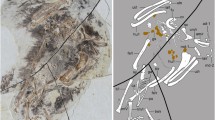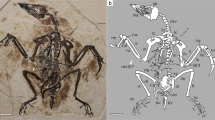Abstract
Confuciusornithids, lived from 120–125 million years ago, form a basal bird group and include the oldest birds with horny beaks. Here we describe Eoconfuciusornis zhengi, gen. et sp. nov. from the Early Cretaceous Dabeigou Formatio (131 Ma) in Fengning, Hebei Province, northern China. It represents a new and, more primitive than other known, member of this group and extends the lifespan of this family to 11 Ma, the longest of any known Early Cretaceous avian lineages. Furthermore, Eoconfuciusornis and its relatives present many osteological transformations, such as the size increase of the deltopectoral crest of the humerus and the keel of the sternum, apparently an adaptation toward improved flight in the evolution of the Confuciusornithidae.
Similar content being viewed by others
References
Chang M M, Chen P J, Wang Y Q, et al, eds. The Jehol Biota. Shanghai: Shanghai Scientific & Technical Publishers, 2003
Feduccia A. The Origin and Evolution of Birds. 2nd ed. New Haven: Yale University Press, 1999
Chiappe L M. Basal bird phylogeny: Problems and solutions. In: Chiappe L M, Witmer L M, eds. Mesozoic Birds. Berkeley: California University Press, 2002. 448–472
Zhou Z H, Zhang F C. Mesozoic birds of China — A synoptic review. Vert PalAsiat, 2006, 44: 18–23
Chiappe L M, Ji S A, Ji Q, et al. Anatomy and systematics of the Confuciusornithidae (Theropoda: Aves) from the Late Mesozoic of Northeastern China. Bull Am Mus Nat Hist, 1999, 242: 1–89
Hou L H, Zhou Z H, Gu Y C, et al. Confuciusornis sanctus, a new Late Jurassic sauriurine bird from China. Chin Sci Bull, 1995, 40(18):1545–1551
Hou L H, Zhou Z H, Martin L D, et al. A beaked bird from the Jurassic of China. Nature, 1995, 377: 616–618
Ji Q, Chiappe L M, Li S A. A new Late Mesozoic confuciusornithid bird from China. J Vertebr Paleontol, 1999, 19(1): 1–7
Hou L H, Zhou Z H, Zhang F C, et al. Mesozoic Birds from Western Liaoning in China. Shenyang: Liaoning Science and Technology Publishing House, 2002
Dalsätt J, Zhou Z H, Zhang F C, et al. Food remains in Confuciusornis sanctus suggest a fish diet. Naturwissenschaften, 2006, 93(9): 444–446
He H Y, Wang X L, Zhou Z H, et al. Timing of the Jiufotang Formation (Jehol Group) in Liaoning, northeastern China and its implications. Geophys Res Lett, 2004, 31(12): L12605, doi: 10.1029/2004GL019790
Swisher III C C, Wang X L, Zhou Z H, et al. Further Support for a Cretaceous age for the feathered-dinosaur beds of Liaoning, China: New 40Ar/39Ar dating of the Yixian and Tuchengzi Formations. Chin Sci Bull, 2002, 47(2): 135–138
Zhou Z H, Barrett P M, Hilton J. An exceptionally preserved Lower Cretaceous ecosystem. Nature, 2003, 421: 807–814
Zhou Z H. Evolutionary radiation of the Jehol Biota: chronological and ecological perspectives. Geol J, 2006, 41: 377–393
Jin F. Middle and Late Mesozoic acipenseriforms from northern Hebei and western Liaoning, China. Palaeoworld, 1999, 11: 188–280
Liu Y Q, Li P X, Tian S G. SHRIMP U-Pb zircon age of Late Mesozoic tuff (lava) in Luanping basin, northern Hebei, and its implications. Acta Petrol Mineral, 2003, 22(3): 237–244
He H Y, Wang X L, Jin F, et al. 40Ar/39Ar dating of the early Jehol Biota from Fengning, Hebei Province, northern China. Geochem Geophys Geosys, 2006, 7, doi: 10.1029/2005GC001083
Benton M J. Vertebrate Palaeontology. 3rd ed. Oxford: Blackwell, 2004
Zhang F C, Zhou Z H. A primitive enantiornithine bird and the origin of feathers. Science, 2000, 290: 1955–1959
Jin F, Tian Y P, Yang Y S, et al. An early fossil sturgeon (Acipenseriformes, Peipiaosteidae) from Fengning of Hebei, China. Vert Pal Asiat, 1995, 33(1): 1–16
Swofford D L. Paup phylogenetic analysis using parsimony (*and other methods). Version 4.0 Sunderland, MA: Sinauer. 1998
Hou L H, Martin L D, Zhou Z H, et al. A diapsid skull in a new species of the primitive bird Confuciusornis. Nature, 1999, 399: 679–682
Romer A S. Osteology of the Reptiles. Chicago and London: The University of Chicago Press, 1956
Zheng G M. Ornithology. Beijing: Beijing Normal University Press, 1995
Zhang F C, Zhou Z H, Hou L H. Birds. In: Chang M M, Chen P J, Wang Y Q, et al, eds. The Jehol Biota. Shanghai: Shanghai Scientific & Technical Publishers, 2003. 129–149
Baumel J J, Witmer L M. Osteologia. In: Baumel J J, King A S, Breazile J E, et al, eds. 2nd ed. Handbook of Avian Anatomy: Nomina Anatomica Avium. Cambridge: Nuttal Ornithological Club, 1993. 45–132
Elzanowski A, Wellnhofer P. Cranial morphology of Archaeopteryx: Evidence from the seventh skeleton. J Vertebr Paleontol, 1996, 16(1): 81–94
Zhang F C, Ericson P G H, Zhou Z H. Description of a new enantiornithine bird from the Early Cretaceous of Hebei, northern China. Can J Earth Sci, 2004, 41: 1097–1107
Zhou Z H, Zhang F C. A long-tailed, seed-eating bird from the Early Cretaceous of China. Nature, 2002, 418: 405–409
Mayr G, Pohl B, Peters D S. A well-preserved Archaeopteryx specimen with theropod features. Science, 2005, 310: 1483–1486
Xu X. Dinosaurs. In: Chang M M, Chen P J, Wang Y Q, et al, eds. The Jehol Biota. Shanghai: Shanghai Scientific & Technical Publishers, 2003. 109–128
Zhang F C, Zhou Z H. Origin and early evolution of feathers and feather-like integuments. In: Rong J Y, Fang Z J, Zhou Z H, et al, eds. Originations, Radiations and Biodiversity Changes-Evidences from the Chinese Fossil Record. Beijing: Science Press, 2006. 611–625, 923–925
Zhang F C, Zhou Z H, Dyke G. Feathers and ‘feather-like’ integumentary structures in Liaoning birds and dinosaurs. Geol J, 2006, 41: 395–404
Martin L D, Zhou Z H, Hou L H, et al. Confuciusornis sanctus compared to Archaeopteryx lithographica. Naturwissenschaften, 1998, 85: 286–289
Author information
Authors and Affiliations
Corresponding author
Additional information
Supported by the National Natural Science Foundation of China (Grant Nos. 40472018, 40121202), the Chinese Academy of Sciences (Grant No. KZCX3-SW-142), the Major Basic Research Projects of the Ministry of Science and Technology of the People’s Republic of China (Gtant No. 2006CB806400), and the Royal Society and Natural Environment Research Council (Grant No. NE/E011055/1)
Rights and permissions
About this article
Cite this article
Zhang, F., Zhou, Z. & Benton, M.J. A primitive confuciusornithid bird from China and its implications for early avian flight. Sci. China Ser. D-Earth Sci. 51, 625–639 (2008). https://doi.org/10.1007/s11430-008-0050-3
Received:
Accepted:
Published:
Issue Date:
DOI: https://doi.org/10.1007/s11430-008-0050-3




